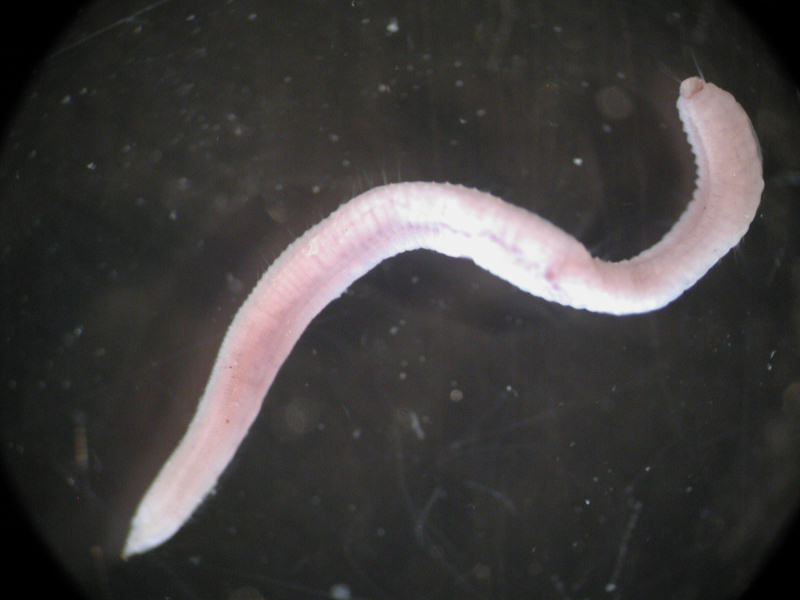A bristleworm (Chaetozone setosa)
Distribution data supplied by the Ocean Biodiversity Information System (OBIS). To interrogate UK data visit the NBN Atlas.Map Help
| Researched by | Sonia Rowley | Refereed by | Admin |
| Authority | Malmgren, 1867 | ||
| Other common names | - | Synonyms | - |
Summary
Description
Recorded distribution in Britain and Ireland
This species can be found around the coasts of Britain and Ireland.Global distribution
-Habitat
Chaetozone setosa is common on muddy and gravel bottoms in the shallow sublittoral.Depth range
-Identifying features
- Cylindrical body with 70-90 segments (chaetigers).
- Body length 20-25 mm.
- Head bears pointed, eyeless prostomium.
- Stout, pointed chaetae towards the end of the body; latter chaetae almost encircle the entire segment.
- Gills on at least 20 initial segments.
Additional information
This species is a sedentary worm feeding on detritus using its long, wrinkled fragile palps. There are several species confused under this name in UK waters (Howson & Picton, 1997).Listed by
- none -
Bibliography
Ball, B.J., Fox, G. & Munday, B.W., 2000. Long- and short-term consequences of a Nephrops trawl fishery on the benthos and environment of the Irish Sea. ICES Journal of Marine Science, 57, 1315-1320.
Bruce, J.R., Colman, J.S. & Jones, N.S., 1963. Marine fauna of the Isle of Man. Liverpool: Liverpool University Press.
Chambers, S.J., 2000. A redescription of Chaetozone setosa Malmgren, 1867 including a definition of the genus, and a description of a new species of Chaetozone (Polychaeta: Cirratulidae) from the northeast Atlantic. Bulletin of Marine Science, 67, 587-596.
Christie, G., 1985. A comparative study of the reproductive cycles of three Northumberland populations of Chaetozone setosa (Polychaeta: Cirratulidae). Journal of the Marine Biological Association of the United Kingdom, 65, 239-254.
Curtis, M.A., 1977. Life cycles and population dynamics of marine benthic polychaetes from the Disko Bay area of W. Greenland. Ophelia, 16, 9-58.
Frid, C.L.J., Clark, R.A. & Hall, J.A., 1999. Long-term changes in the benthos on a heavily fished ground off the NE coast of England. Marine Ecology Progress Series, 188, 13-20.
Hayward, P., Nelson-Smith, T. & Shields, C. 1996. Collins pocket guide. Sea shore of Britain and northern Europe. London: HarperCollins.
Hayward, P.J. & Ryland, J.S. (ed.) 1995b. Handbook of the marine fauna of North-West Europe. Oxford: Oxford University Press.
Hily, C., 1987. Spatio-temporal variability of Chaetozone setosa (Malmgren) populations on an organic gradient in the Bay of Brest, France. Journal of Experimental Marine Biology and Ecology, 112, 201-216.
Howson, C.M. & Picton, B.E., 1997. The species directory of the marine fauna and flora of the British Isles and surrounding seas. Belfast: Ulster Museum. [Ulster Museum publication, no. 276.]
Kenchington, E.L.R., Prena, J., Gilkinson, K.D., Gordon, D.C., Macisaac, K., Bourbonnais, C.; Schwinghamer, P.J., Rowell, T.W., McKeown, D.L. & Vass, W.P., 2001. Effects of experimental otter trawling on the macrofauna of a sandy bottom ecosystem on the Grand Banks of Newfoundland. Canadian Journal of Fisheries and Aquatic Sciences, 58, 1043-1057.
Picton, B.E. & Costello, M.J., 1998. BioMar biotope viewer: a guide to marine habitats, fauna and flora of Britain and Ireland. [CD-ROM] Environmental Sciences Unit, Trinity College, Dublin.
Sparks-McConkey, P.J. & Watling, L., 2001. Effects on the ecological integrity of a soft-bottom habitat from a trawling disturbance. Hydrobiologia, 456, 73-85.
Tuck, I.D., Hall, S.J., Robertson, M.R., Armstrong, E. & Basford, D.J., 1998. Effects of physical trawling disturbance in a previously unfished sheltered Scottish sea loch. Marine Ecology Progress Series, 162, 227-242.
Datasets
Centre for Environmental Data and Recording, 2018. Ulster Museum Marine Surveys of Northern Ireland Coastal Waters. Occurrence dataset https://www.nmni.com/CEDaR/CEDaR-Centre-for-Environmental-Data-and-Recording.aspx accessed via NBNAtlas.org on 2018-09-25.
Environmental Records Information Centre North East, 2018. ERIC NE Combined dataset to 2017. Occurrence dataset: http://www.ericnortheast.org.ukl accessed via NBNAtlas.org on 2018-09-38
NBN (National Biodiversity Network) Atlas. Available from: https://www.nbnatlas.org.
OBIS (Ocean Biodiversity Information System), 2025. Global map of species distribution using gridded data. Available from: Ocean Biogeographic Information System. www.iobis.org. Accessed: 2025-08-14
South East Wales Biodiversity Records Centre, 2018. SEWBReC Worms (South East Wales). Occurrence dataset: https://doi.org/10.15468/5vh0w8 accessed via GBIF.org on 2018-10-02.
Citation
This review can be cited as:
Last Updated: 10/10/2006



